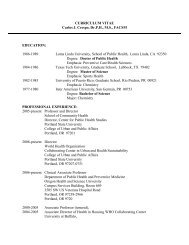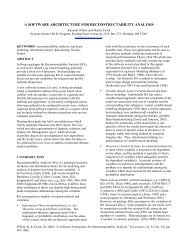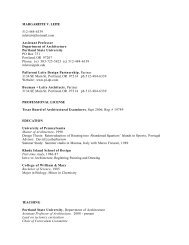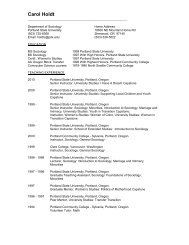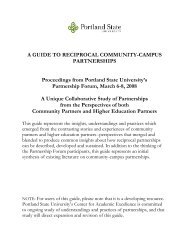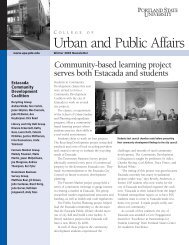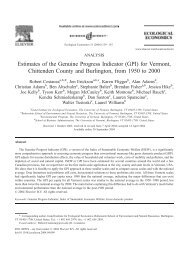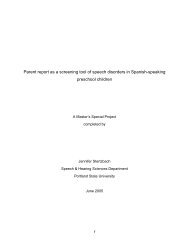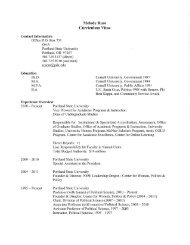Effects of integral stimulation therapy on speech - Portland State ...
Effects of integral stimulation therapy on speech - Portland State ...
Effects of integral stimulation therapy on speech - Portland State ...
You also want an ePaper? Increase the reach of your titles
YUMPU automatically turns print PDFs into web optimized ePapers that Google loves.
to elicit accurate <strong>speech</strong> sounds first in isolati<strong>on</strong>, then at syllable level, and finally at<br />
word and phrase levels. Supports were added and withdrawn from treatment depending<br />
<strong>on</strong> the child’s success. Many successful producti<strong>on</strong>s <str<strong>on</strong>g>of</str<strong>on</strong>g> <strong>speech</strong> target sounds (blocked)<br />
were required before the sound was practiced in a random manner. This allowed<br />
maximum opportunity to master <strong>speech</strong> sounds before applying the motor skills to more<br />
challenging c<strong>on</strong>texts (multiple target sounds in <strong>on</strong>e activity, practice in a play activity,<br />
practice while discussing a picture book).<br />
The frequency <str<strong>on</strong>g>of</str<strong>on</strong>g> motor <strong>speech</strong> practice varied up<strong>on</strong> the level <str<strong>on</strong>g>of</str<strong>on</strong>g> difficulty for<br />
each task, the child’s age and motivati<strong>on</strong>, and activity design. A study by Edeal (2008),<br />
including 2 children with moderate to severe CAS, c<strong>on</strong>cluded that “frequent and intense<br />
practice <str<strong>on</strong>g>of</str<strong>on</strong>g> <strong>speech</strong> sounds in the c<strong>on</strong>text <str<strong>on</strong>g>of</str<strong>on</strong>g> <str<strong>on</strong>g>integral</str<strong>on</strong>g> <str<strong>on</strong>g>stimulati<strong>on</strong></str<strong>on</strong>g> <str<strong>on</strong>g>therapy</str<strong>on</strong>g> resulted in faster<br />
acquisiti<strong>on</strong> <str<strong>on</strong>g>of</str<strong>on</strong>g> the targets, better in sessi<strong>on</strong> performance, and more generalizati<strong>on</strong> to<br />
untrained probe words…” (p. 95). Every effort was made to maximize as many correct<br />
producti<strong>on</strong>s <str<strong>on</strong>g>of</str<strong>on</strong>g> target sounds in a variety <str<strong>on</strong>g>of</str<strong>on</strong>g> c<strong>on</strong>texts. It was noted that fewer producti<strong>on</strong>s<br />
(30 to 40) were achieved during sessi<strong>on</strong>s that CP was feeling overly tired, sick, or<br />
restless. During sessi<strong>on</strong>s when CP was highly motivated, attentive, and healthy CP was<br />
able to produce up to 100 producti<strong>on</strong>s <str<strong>on</strong>g>of</str<strong>on</strong>g> target <strong>speech</strong> sounds during a treatment sessi<strong>on</strong>.<br />
CP’s ability to judge, correct, and prepare for accurate <strong>speech</strong> producti<strong>on</strong>s showed<br />
marked improvement over the course <str<strong>on</strong>g>of</str<strong>on</strong>g> this study. He relied <strong>on</strong> clinician feedback less as<br />
his skills at self evaluati<strong>on</strong> developed. After several weeks <str<strong>on</strong>g>of</str<strong>on</strong>g> treatment, CP’s mother<br />
noticed him making multiple attempts at words c<strong>on</strong>taining target <strong>speech</strong> sounds, pausing<br />
before those attempts, and asking for words to be modeled for him at home. She practiced<br />
his target <strong>speech</strong> sounds with him in a variety <str<strong>on</strong>g>of</str<strong>on</strong>g> envir<strong>on</strong>ments which allowed him to<br />
65



